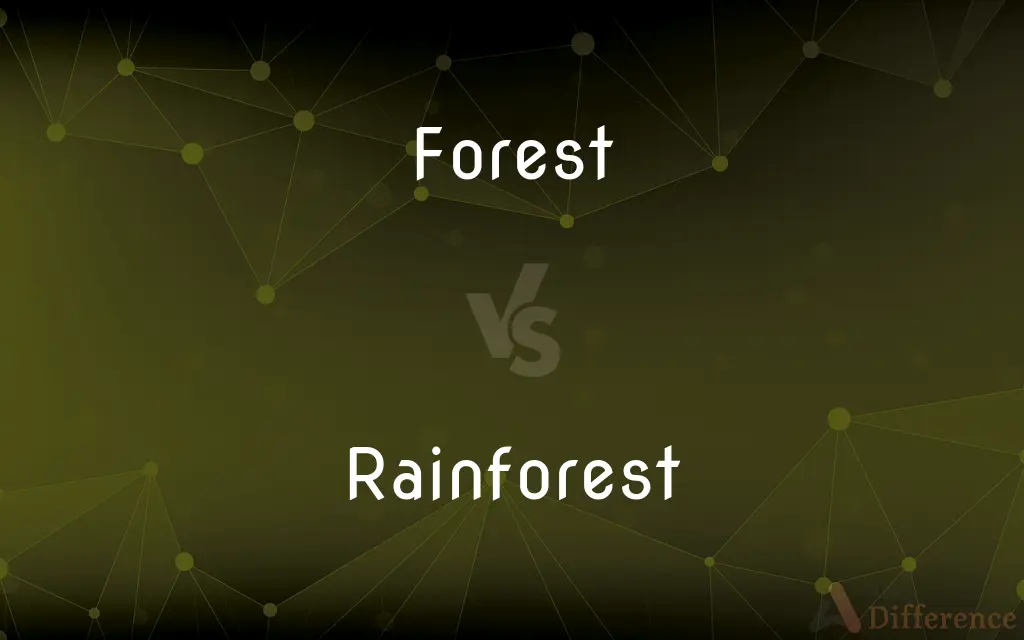Forest vs. Rainforest — What's the Difference?
Edited by Tayyaba Rehman — By Fiza Rafique — Updated on March 7, 2024
A forest is a large area covered with trees, while a rainforest is a dense, wet forest found in tropical regions.

Difference Between Forest and Rainforest
Table of Contents
ADVERTISEMENT
Key Differences
Forests are diverse ecosystems that can exist in various climates, ranging from the cold boreal forests near the Arctic to the temperate forests found in many regions around the world. They are characterized by their tree coverage, which can vary in density, species, and size. Rainforests, on the other hand, are specific types of forests characterized by high rainfall, typically exceeding 1750-2000 mm (69-78 inches) annually, and are primarily located near the Earth's equator.
While all rainforests are forests, not all forests are rainforests. Rainforests are known for their incredible biodiversity, housing a vast array of plant and animal species, many of which are not found anywhere else in the world. Other types of forests, such as deciduous or coniferous forests, have their own unique ecosystems but generally do not support the same level of biodiversity as rainforests.
Rainforests play a crucial role in the Earth's climate system, acting as significant carbon sinks that help regulate global temperatures. While forests, in general, contribute to carbon sequestration, rainforests are particularly efficient due to their dense vegetation and rapid biomass turnover. In contrast, other forest types, such as boreal forests, store carbon primarily in soil and biomass but at a different scale.
The distinction between forests and rainforests is not only ecological but also climatic. Rainforests are found in regions with consistently high humidity and temperatures throughout the year, contributing to their dense undergrowth and canopy layers. Other forest types experience more varied seasonal changes, which influence their flora and fauna differently.
Comparison Chart
Climate Variability
Can vary widely
Consistently warm and humid
ADVERTISEMENT
Location
Global, across various latitudes
Primarily equatorial and tropical
Biodiversity
Varies, less than rainforests
Extremely high
Rainfall
Variable, depending on type
Typically > 1750-2000 mm annually
Carbon Sequestration
Significant, varies by type
Extremely high, rapid biomass turnover
Compare with Definitions
Forest
A large area covered chiefly with trees and undergrowth.
The vast forest was home to many species of birds and mammals.
Rainforest
A luxuriant, dense forest rich in biodiversity, found typically in tropical areas with consistently high rainfall.
The Amazon rainforest is one of the Earth's largest reservoirs of biodiversity.
Forest
Land dominated by woody vegetation.
The forest provided valuable timber resources for the community.
Rainforest
A tropical forest with tall trees, a high annual rainfall, and a high average temperature.
Exploring the rainforest revealed an incredible variety of plants and animals.
Forest
An area designated for the cultivation and preservation of trees.
The newly planted forest will help restore the area's natural habitat.
Rainforest
An ecosystem known for its layers, such as the emergent, canopy, understory, and forest floor.
Each layer of the rainforest supports different types of wildlife.
Forest
A dense collection of trees covering a large area.
They went camping in the national forest over the weekend.
Rainforest
A woodland characterized by a closed canopy of moisture-loving plants.
Rainforests play a vital role in the Earth's oxygen production and carbon storage.
Forest
A complex ecosystem containing various plant and animal species.
Conservation efforts are crucial to protect the forest's biodiversity.
Rainforest
A forest that receives a high amount of rain and supports a wide variety of life.
The protection of rainforests is crucial for maintaining global biodiversity.
Forest
A forest is an area of land dominated by trees. Hundreds of definitions of forest are used throughout the world, incorporating factors such as tree density, tree height, land use, legal standing and ecological function.
Rainforest
Rainforests are characterized by a closed and continuous tree canopy, moisture-dependent vegetation, the presence of epiphytes and lianas and the absence of wildfire. Rainforest can be classified as tropical rainforest or temperate rainforest, but other types have been described.
Forest
A large area covered chiefly with trees and undergrowth
A pine forest
A large tract of forest
Rainforest
A dense evergreen forest with a minimum annual rainfall of approximately 180 centimeters (71 inches). Rainforests are found chiefly in the tropics but also occur in temperate regions, where the rainfall amount is somewhat lower.
Forest
A large number or dense mass of vertical or tangled objects
A forest of high-rise apartments
Rainforest
A forest in a climate with high annual rainfall and no dry season.
Forest
Cover (land) with forest; plant with trees
A forested hillside
Rainforest
A forest with heavy annual rainfall
Forest
A growth of trees and other plants covering a large area.
Forest
A large number of objects bearing a similarity to such a growth, especially a dense collection of tall objects
A forest of skyscrapers.
Forest
A defined area of land formerly set aside in England as a royal hunting ground.
Forest
To plant trees on or cover with trees.
Forest
A dense uncultivated tract of trees and undergrowth, larger than woods.
Forest
Any dense collection or amount.
A forest of criticism
Forest
(historical) A defined area of land set aside in England as royal hunting ground or for other privileged use; all such areas.
Forest
(graph theory) A graph with no cycles; i.e., a graph made up of trees.
Forest
A group of domains that are managed as a unit.
Forest
The colour forest green.
Forest
(transitive) To cover an area with trees.
Forest
An extensive wood; a large tract of land covered with trees; in the United States, a wood of native growth, or a tract of woodland which has never been cultivated.
Forest
A large extent or precinct of country, generally waste and woody, belonging to the sovereign, set apart for the keeping of game for his use, not inclosed, but distinguished by certain limits, and protected by certain laws, courts, and officers of its own.
Forest
Of or pertaining to a forest; sylvan.
Forest
To cover with trees or wood.
Forest
The trees and other plants in a large densely wooded area
Forest
Land that is covered with trees and shrubs
Forest
Establish a forest on previously unforested land;
Afforest the mountains
Common Curiosities
What are the main layers of a rainforest?
Rainforests are structured into layers: the emergent layer, canopy, understory, and forest floor, each hosting unique flora and fauna.
How do temperate forests differ from tropical rainforests?
Temperate forests are found in cooler climates with distinct seasons, while tropical rainforests are located near the equator with consistent warmth and high rainfall.
What role do rainforests play in climate regulation?
Rainforests regulate the Earth's climate by storing carbon dioxide, producing oxygen, and influencing rainfall patterns both locally and globally.
Can forests exist in desert regions?
Yes, some forests, like dry forests or woodland areas, can exist in arid or semi-arid regions, though they are less dense than those in wetter climates.
What is the importance of conserving forests and rainforests?
Conservation is crucial for preserving biodiversity, fighting climate change, and maintaining essential ecological processes.
How is biodiversity maintained in a forest?
Biodiversity in forests is maintained through natural processes like seed dispersal, pollination, and the presence of various habitats within the forest ecosystem.
Why are rainforests often called the "lungs of the Earth"?
Because they produce a significant portion of the Earth's oxygen through photosynthesis and absorb large amounts of carbon dioxide.
What are some common threats to forests and rainforests?
Deforestation, climate change, pollution, and habitat destruction are major threats to both forests and rainforests.
What measures can be taken to protect rainforests?
Protecting rainforests involves enforcing laws against illegal logging, supporting sustainable land use practices, and promoting conservation efforts.
How do animals adapt to life in the rainforest?
Animals adapt through various means like camouflage, diet specialization, and developing symbiotic relationships with other species.
Can reforestation help restore forest areas?
Yes, reforestation can help restore degraded forest areas, improve biodiversity, and enhance carbon sequestration.
How do forest fires affect ecosystems?
Forest fires can lead to habitat destruction and loss of biodiversity, but in some ecosystems, they are natural occurrences that contribute to regeneration.
How do seasonal changes affect temperate forests?
Seasonal changes lead to variations in temperature, daylight, and weather patterns, affecting plant growth cycles, animal behaviors, and overall forest dynamics.
What is the significance of the canopy layer in a rainforest?
The canopy layer is significant for its high density of foliage, serving as a habitat for a vast number of species and playing a crucial role in photosynthesis.
How does human activity impact forests and rainforests?
Human activities like logging, agriculture, and urban development can lead to habitat loss, reduced biodiversity, and altered ecosystems.
Share Your Discovery

Previous Comparison
Cougar vs. Puma
Next Comparison
Academia vs. AcademicAuthor Spotlight
Written by
Fiza RafiqueFiza Rafique is a skilled content writer at AskDifference.com, where she meticulously refines and enhances written pieces. Drawing from her vast editorial expertise, Fiza ensures clarity, accuracy, and precision in every article. Passionate about language, she continually seeks to elevate the quality of content for readers worldwide.
Edited by
Tayyaba RehmanTayyaba Rehman is a distinguished writer, currently serving as a primary contributor to askdifference.com. As a researcher in semantics and etymology, Tayyaba's passion for the complexity of languages and their distinctions has found a perfect home on the platform. Tayyaba delves into the intricacies of language, distinguishing between commonly confused words and phrases, thereby providing clarity for readers worldwide.













































